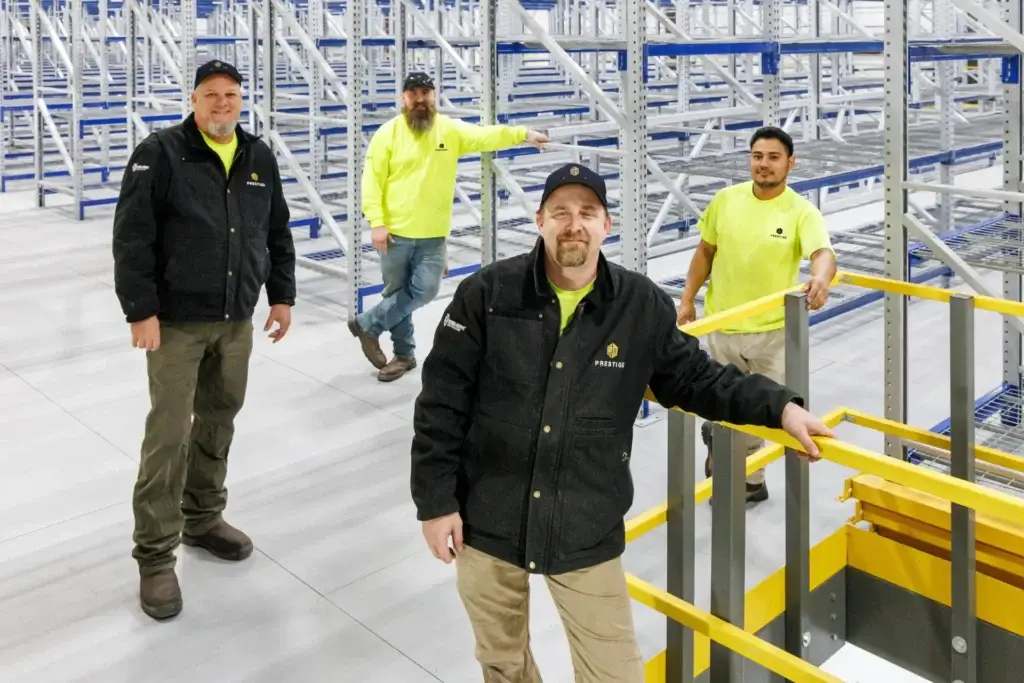Warehouse Space Transformation

Revolutionizing Warehouse Space
The Path to Operational Excellence
In today’s rapidly evolving logistics and e-commerce landscape, warehouse space transformation has become a critical strategy for businesses aiming to optimize operations and maintain a competitive edge. Warehouse space transformation is the process of optimizing and redesigning warehouse facilities to maximize efficiency, capacity, and functionality. It involves reorganizing layout, leveraging innovative technologies, implementing vertical storage solutions, and adopting flexible systems to make the most of available space. This approach aims to streamline operations, improve inventory management, and create adaptable environments that can meet the demands of modern logistics and e-commerce” to “This approach aims to streamline operations, improve inventory management, and create adaptable environments that can meet the demands of modern businesses.
Warehouse transformation goes beyond simple reorganization, encompassing a full reimagining of how space is utilized to drive operational excellence and competitive advantage. At Prestige, we specialize in transforming warehouse space, offering insights into modern techniques, technologies, and solutions that can help unlock your facility’s full potential.
Options to Transform Your Space
Enhancing Efficiency and Precision
Several key options are available for businesses looking to transform their warehouse:
- Mezzanines: These elevated platforms utilize vertical space, creating additional areas for storage, offices, or production. Mezzanines offer a cost-effective way to increase usable square footage without expanding the building’s footprint.
- Modular Offices: Modular offices are prefabricated structures that can be easily integrated into warehouse environments, providing flexible solutions for administrative spaces, labs, or clean rooms.
- Wire Partitions: Secure systems that allow for the creation of distinct areas within a warehouse, wire partitions enhance security and organization while maintaining visibility.
Vinyl Curtains: Versatile dividers offer options for temperature control, dust containment, and noise reduction, with the ability to be retracted when not in use. - Vinyl Curtains: Versatile dividers offer options for segmentation of areas, temperature control, dust and debris containment, and noise reduction, with the ability to be retracted when not in use.
Each of these options can be customized to fit specific needs, allowing for tailored solutions that address unique operational challenges and goals.
Benefits of Space Transformation
Transforming warehouses comes with advantages that can significantly impact a business’s bottom line and operational capabilities. From maximizing storage capacity to enhancing efficiency, the benefits of warehouse transformation are far-reaching and impactful. Let’s explore the key benefits that make this process a game-changer for modern warehousing operations.
- Increased Storage Capacity: Businesses can increase their storage capacity without expanding their physical footprint by utilizing vertical space and implementing efficient storage systems.
- Improved Operational Efficiency: Optimized layouts and advanced technologies lead to streamlined workflows, reduced travel time, and faster order fulfillment.
- Enhanced Inventory Management: Better organization and visibility improve inventory accuracy and reduce carrying costs.
Cost Savings: Efficient use of existing space can help avoid costly relocations or expansions. - Cost Savings: Efficient use of existing space and technologies not only boosts productivity but also significantly reduces operating costs by minimizing the need for expensive expansions or new facilities.
- Improved Safety: Well-designed spaces with proper organization can reduce accidents and improve workplace safety.
- Flexibility: Adaptable designs allow businesses to quickly respond to changing market demands and operational needs.
Upgrading to Automated Storage Solutions for Space Transformation
Enhancing Efficiency and Precision
Upgrading from traditional to automated storage solutions plays a major role in warehouse space transformation, optimizing layout, reducing wasted space, and improving efficiency. Here’s how:
- Vertical Lift Modules (VLMs): Transitioning to VLMs maximizes vertical space, providing high-density storage and rapid item retrieval. This upgrade enhances inventory accuracy and picking efficiency.
- Mobile Racking Systems: Replacing traditional racks with mobile systems eliminates fixed aisles, significantly increasing storage capacity by allowing racks to move along tracks. This upgrade maximizes storage density without expanding physical space.
- Automated Storage and Retrieval Systems (AS/RS): Switching to AS/RS involves using cranes or shuttles for efficient item storage and retrieval. These systems reduce retrieval times, boost accuracy, and optimize vertical space utilization.
- Pallet Shuttle Systems: Employing pallet shuttles within racking systems automates the storage and retrieval of pallets, enhancing space utilization and reducing the time operators spend on loading and unloading. This system is ideal for high-throughput warehouses with repetitive loading patterns.
- Conveyor Systems: Integrating conveyor systems automates the movement of goods, enhancing throughput and reducing labor costs. Conveyors work seamlessly with other automated solutions, creating a cohesive and efficient system.
By upgrading to automated storage solutions, warehouses can transform their space for greater efficiency, better space utilization, and enhanced operational capabilities.
Challenges to Effective Space Transformation
While the benefits are significant, transforming warehouses also presents several challenges:
- Initial Investment Costs: Implementing new systems and redesigning spaces requires upfront investment.
- Operational Disruptions: Transformation projects may temporarily disrupt normal operations, requiring careful planning and phased implementation.
- Employee Training and Adaptation: New systems and layouts often require training, and employees accustomed to old methods may resist them.
- Integration of Legacy Systems: Ensuring new technologies work with existing systems can be complex and time-consuming.
- Regulatory Compliance: Changes to warehouse layout and operations must comply with various safety and industry regulations.
- Balancing Automation and Human Labor: Finding the right balance between automated systems and human workers can be challenging.
Warehouse transformation is an art combining innovative design, cutting-edge technology, and strategic planning. By embracing vertical storage solutions, flexible partitioning systems, modular offices, and advanced technologies, businesses can unlock the full potential of their warehouses. As the logistics and e-commerce sectors continue to evolve, adapting and optimizing warehouses will become increasingly crucial for maintaining competitiveness. Partnering with experienced providers like Prestige can help navigate the complexities of space transformation, ensuring that your facility is equipped to meet today’s and tomorrow’s challenges.

Transforming Spaces
Tailored Solutions and Expert Partnerships
At Prestige, we are pioneers in warehouse services, carrying forward a legacy of innovative solutions since our founding.
Prestige stands out for its comprehensive services and tailored solutions. Our expert team, capable of traveling nationally but focused heavily in the Southeast, offers turnkey project management. We don’t just sell products; we partner with our clients to identify optimal storage and material handling solutions, supporting them throughout the entire process from sale and installation to aftermarket service.
Our core values of quality, integrity, adaptability, customer focus, hard work, and teamwork are the pillars of our success. These principles guide us in delivering exceptional results, fostering trust, and maintaining our position as industry leaders.
With a wide range of offerings including mezzanines, modular offices, partitions, and enclosures, we transform spaces to maximize efficiency and productivity. Our solutions are engineered and designed with your specific needs in mind, ensuring economical and effective use of every square foot.
At Prestige, we’re not just transforming warehouses; we’re shaping the future of industrial efficiency. Join us in unlocking the potential of your facility.
FAQ
Commonly Asked Questions
What is warehouse space transformation?
Warehouse space transformation is a comprehensive process of optimizing and redesigning warehouse facilities to enhance efficiency, capacity, and functionality. It encompasses a range of strategies, including implementing vertical storage solutions, integrating new technologies, reorganizing layouts, and adopting flexible partitioning systems. The goal is to maximize space utilization, streamline operations, and create a more adaptable and efficient warehouse environment that can meet the evolving demands of modern logistics and e-commerce.
How can I maximize space in a warehouse?
Maximizing space in a warehouse involves a multi-faceted approach that combines various strategies and technologies. Start by utilizing vertical space with mezzanines and high-bay racking systems to maximize your facility’s height. Implement narrow aisle configurations to increase storage density and use modular and flexible storage solutions that can adapt to changing needs. Optimize your supply chain management with advanced technologies like WMS and IoT devices to guarantee efficient use of space. Consider automated storage and retrieval systems for high-density storage and faster picking. Regularly analyze your operations and adjust your layout based on data-driven insights to continually improve space utilization.
How does technology improve warehouse efficiency?
Technology enhances warehouse efficiency through advanced automated storage solutions. Vertical Lift Modules (VLMs) maximize vertical space usage, improving storage density and item retrieval speed. Mobile racking systems increase storage capacity by eliminating fixed aisles, allowing for flexible space utilization. Automated Storage and Retrieval Systems (AS/RS) use cranes or shuttles for efficient item handling, reducing retrieval times and boosting accuracy. Conveyor systems automate goods movement, enhancing throughput and reducing labor costs. Real-time inventory management systems provide instant visibility into stock levels and locations. By upgrading to these automated solutions, warehouses can transform their space for greater efficiency, better utilization, and enhanced operational capabilities. This technological shift leads to higher throughput, lower costs, and improved customer satisfaction through faster, more accurate order fulfillment.
